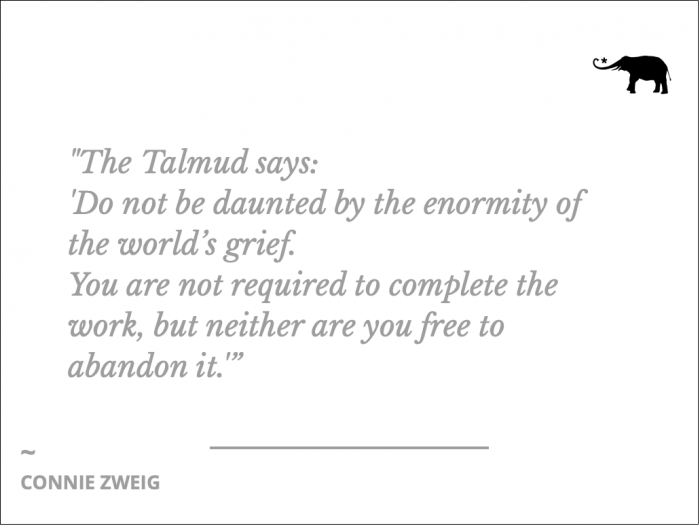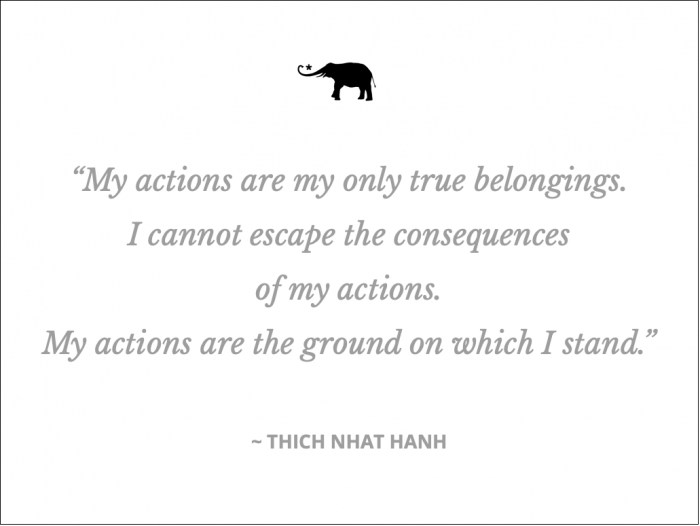The teaching of service appears in every religious tradition.
In Christianity, service and good works are an attempt to imitate the life of Christ.
In Sufism, service means serving the Beloved by serving others.
In Buddhism, service and compassion for loved ones, teachers, and all living beings are part of the Eightfold path and the Bodhisattva vow. Thich Nhat Hanh extended these teachings by applying them to social, political, and environmental injustice.
In Hinduism, karma yoga is a path to the divine that purifies the mind and opens the heart. Its proponents teach that selfless right action is a kind of prayer because it’s performed for the benefit of others, without the ego’s attachment to outcomes. With karma yoga, we focus on the actions of daily life as spiritual practice.
In Judaism, “tikkun olam“ means “repairing the world,” or gathering the holy sparks that are scattered in creation through generous acts of service. The performance of good deeds (or mitzvot in the story) is one way of repairing the world. The Talmud says:
“Do not be daunted by the enormity of the world’s grief. You are not required to complete the work, but neither are you free to abandon it.”
Many people hear a call to serve something larger than themselves, but not everyone can identify the issue, cause, or candidate that arouses that passion within them. When they find it, not all will be able to imagine standing up in the public arena about it.
What stops us from finding our voice? Which shadow within needs romancing, so that it doesn’t keep us from giving our gift of service?
Professor of psychiatry, philosophy, anthropology, and religious studies, Dr Roger Walsh, MD, PhD, has outlined this path of service as a path of evolution:
1. Stop before activity, breathe, become present to your purpose.
2. Offer the activity to God or the divine, as you understand this.
3. Choose an intention. Ask what is this for—survival, comfort, awakening, or the benefit of others?
4. Do the activity as impeccably as you can.
5. Be mindful, observing your actions, intentions, and mental state.
6. Work with any reactions that arise, such as anxiety, anger, pride, hope, disappointment, and use shadow work here.
7. Release attachment to the outcome. Use the witness to let it go.
8. Stop at the end of the activity.
9. Reflect and learn about your action, its results, your ego, your mind, and your attachments.
10. Offer the benefits to the well-being of all.
Roger pointed out that these guidelines combine a transpersonal motive beyond ego, a commitment to impeccability that requires cutting through personal blocks, and a letting go of egocentric control.
He told me:
“We go into ourselves in spiritual practice to go more effectively out into the world. And we go out into the world in order to go deeper into ourselves through the practice of karma yoga and awakening service. And we repeat this cycle until we realize that we and the world are one.”
All of the great traditions, then, teach about the evolution of the soul through service.
By opening to the momentary circumstances of our lives and attuning to the inner call, reaching past our small self-preoccupations, letting go of our ego’s agenda, and connecting with the soul of another, service becomes a spiritual path. It becomes the means of our evolution.
Now is the time for us to stand in the public square, march, organize, teach, and support those leaders whose values resonate with us and whose visions offer hope. Now is the time to give the gift that only we can give.
~












Read 1 comment and reply